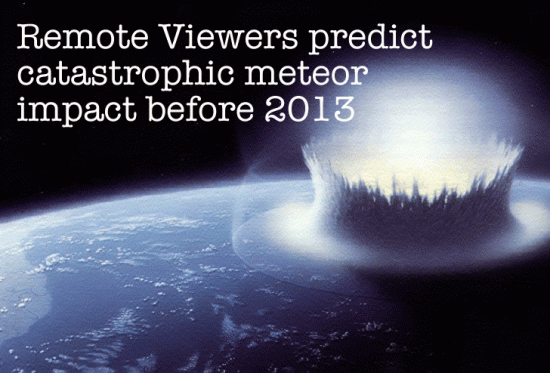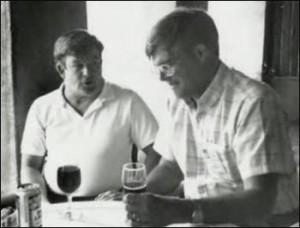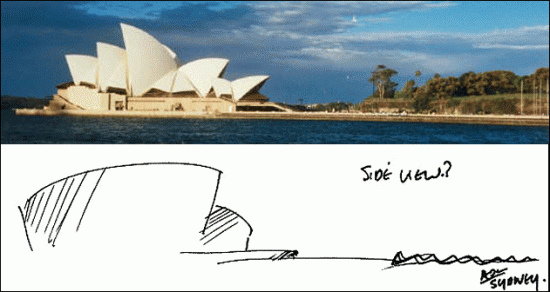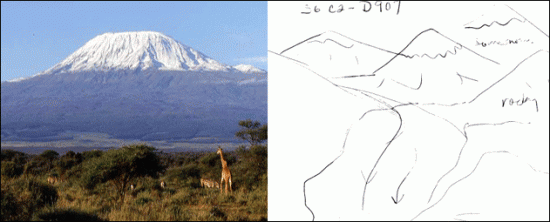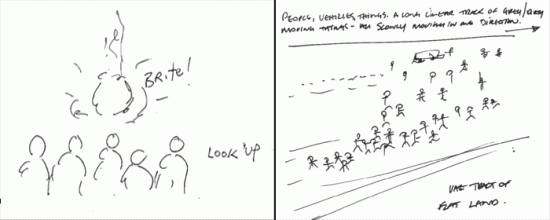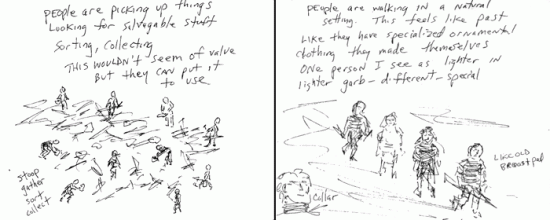View-Zone
This story will blow your mind. That’s what usually happens to us when we learn something about the world that seems totally irrational — but true. In this story we are dealing with time, the future to be exact, and the existence of multiple and different futures.
But wait! If you think this is some pseudo-science, you’re dead wrong. Because the proof of this scientificdiscovery comes with a hefty price tag: a global disaster by 2013.
Back in 2008 some predictions were made by a team of the top, military trained “remote viewers” — each with over a decade of successful service. Lyn Buchanan from US Army Intelligence and Glenn Wheaton, of US Special Forces participated in a project run by Farsight Institute originally designed to detect minute climate changes at selected targets around the globe. Instead of climate change, the remote viewers saw a huge meteoric impact in the ocean with devastating tidal waves and volcanism. All this happening by 2013.
The results were unexpected but should be taken seriously. It appears that the governments of the world are already preparing for such an event. The scientific community believes these predictions to be so strong and reliable that they proposed to let the reputation of remote viewing, as a science, rest upon this horrible prediction.
You need to know about this. It’s real.
First, what is Remote Viewing?
Remote Viewing is a talent where some individuals can get information from events and places that are far away in both distance and time. The phenomenon is not completely understood but has been repeatedly validated by experiments.
Remote viewing was popularized in the 1990s, following the declassification of documents related to the Stargate Project, a $20 million research program sponsored by the U.S. Federal Government to determine if there was any potential military application of psychic phenomena. The program was “terminated” in 1995, citing a lack of documented evidence that the program had any value to the intelligence community. At least that’s the “official” position.
Many believe that the abilities of Remote Viewers are present in most people, and can be developed with the right instruction. That alone is perhaps reason enough to “officially” deny that it has any value.
and then those 2012/2013 predictions! In remote viewing there are always three events that take place: the Remote Viewing Attempt (RVA), where the remote viewer actually tries to see the target event in the future. Then there is the target event (TE) — the thing the remote viewer is trying to see — and finally the Task Assignment (TA) — where some person gives the assignment of what the remote viewer should be looking for.
When remote viewing a future event, the traditional protocol was of the order TA – RVA – TE. In other words, some person would sit the remote viewer down and explain the time and location of some future event (TA), then the Remote Viewer would attempt to ‘see’ it and describe it (RVA), and finally there is the actual event that happens later (TE). This makes sense to us. It’s the linear progression of time. But the procedure didn’t always result in good predictions.
Some researchers tried a different sequence of RVA – TE – TA and it worked much better. According to Farsight Institute’s spokesman, Dr. Courtney Brown:
“We have successfully been able to, in a deterministic manner, describe the future each and every time.” [*]In this protocol, the remote viewer is still attempting to describe a future event, but the person assigning the task does so only after the Remote Viewer has viewed and described the target. Confused?
An example of this highly successful protocol follows: It’s January. The remote viewer is asked to ‘see’ some future event that will be assigned to him in March. With that instruction, some event is seen, written down or drawn and then put in a safe. It is known only to the remote viewer. In March, the target is assigned to the same Remote Viewer — who has already made his predictions two months earlier. The target is some event that happened in February.
It sounds irrational but it works. Why?
At each moment we are at an intersection with many paths leading to future events. By placing some known event in the future we are, in effect, calling out or putting up a sign that says, “Over here! This is the real timeline!” In order to “see” the future accurately there must be a “marker” event — an attractor of sorts — to pull us in to certain paths of possibilities. Since the target event was chosen in the future, the unique future where the event happened has been established. The path is then followed by the remote viewer, allowing him to visualize the events of the future. It can therefore be predicted.
Here’s a great video in which Dr. Brown explains the protocol for describing future events. His terms are a bit different from my explanation but the meaning is the same.
Remote Viewing 2012-2013: not good news…
In 2008 a team of 8 military grade remote viewers were asked to view several targets with the understanding that the actual target assignments for each session would be given to them in the future. The sessions were given a number (S1, S2…) and the notes and drawings from each session were collected, scanned, encrypted and subsequently downloaded by tens of thousands of internet users for some future date, when the encryption codes would be published. This guaranteed that the results of the remote viewing sessions could not be changed.
There was a total of 113 sessions. Once the sessions had been recorded, the targets were selected in a random manner, pairing each session with one of three possible target conditions in 9 different locations around the globe:
1. Vaitupu, Tuvalu
2. Fort Jesus, Mombasa Kenya
3. Sydney Opera House, Sydney, Australia
4. Mount Kilimanjaro, Tanzania
5. United States Congress Building, Washington, D.C.
6. Malé International Airport, Malé, Maldives
7. KITV Building, Honolulu, Hawaii
8. The Vehicle Assembly Building at Launch Complex 39, Kennedy Space Center, Merritt Island, Florida
9. Key West, Florida
The three conditions were:
1. The date of June 2008
A. “June 1, 2013, 12 noon target local time, following the timeline in which the leadership of the mainstream global scientific establishment continues to ignore or deny (1) the reality of the remote-viewing phenomenon, and (2) the existence of life not originating from Earth.”
B. “June 1, 2013, 12 noon target local time, following the timeline in which by the end of 2009 leaders of the mainstream global scientific establishment publicly recognize (1) the reality of the remote-viewin phenomenon, and (2) the existence of life not originating from Earth.”
Each remote viewing session that had already been recorded was associated with a specific geographic location and condition. The results, originally thought to show changes in sea levels and climate, were dramatic.
Those sessions which were linked to assignments in 2008 showed the locations as they were. An example is seen below. This session was linked to the Sydney Opera House (at sea level).
1. Impacts from what appear to be large meteors leading to tsunamis and possible volcanism
2. Extensive and forceful flooding of coastal areas
3. Excessive solar radiation
4. Storms and other severe weather
In terms of the effects of these changes on humans, these data also suggest:
1. Massive self-organized relocation from coastal areas (refugees)
2. The breakdown of rescue or other notable governmental functioning
3. The breakdown of the food supply system
4. The breakdown of the vehicular transport system
5. Extensive loss of buildings near coasts
source
